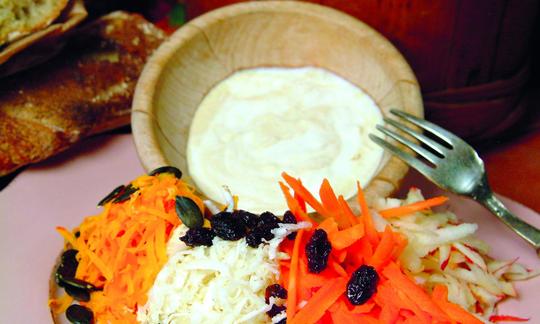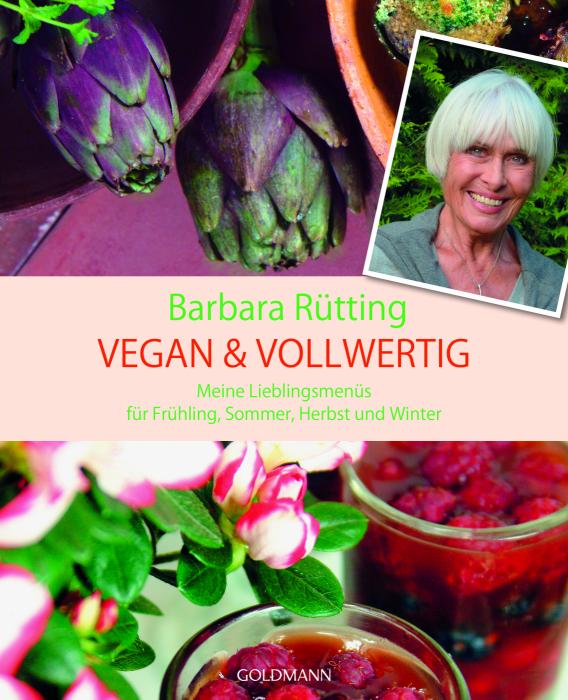Colorful Fall Salad with Nasturtium, Pumpkin, and Spinach
vegan
Ingredients (for servings, )
| For the fall salad | |
|---|---|
| 4 | Carrots (carrots), raw (organic?) (8.6 oz) |
| 1 | Celeriac, raw (organic?) (31 oz) |
| 4 | Apples, raw, with peel (21 oz) |
| 7 ⅓ oz | Pumpkins, raw (vegan pumpkin recipes) |
| 3 ½ oz | Spinach, raw (vegetable spinach) |
| For the dressing | |
| 5 ½ oz | Cashew nuts, raw? organic? (cashew nuts) |
| 150 ml | Drinking water, raw (organic?) (5.3 oz) |
| 1 tbsp | Horseradish, raw (organic?) (0.49 oz) |
| 1 tbsp | Lemon juice (raw?, organic?) (0.26 oz) |
| 1 tsp | Mustard (Mostert, Mostrich, raw?, organic?) (0.18 oz) |
| 1 dash | Table salt (table salt, raw?, organic?) (0.01 oz) |
| 1 dash | Black pepper (organic?, raw?) (0.00 oz) |
| For serving | |
| 1 tbsp | Almonds (sweet almonds), raw (0.35 oz) |
| 1 tbsp | Raisins, raw? (organic?) (0.32 oz) |
| 1 tbsp | Pumpkin seeds, dried, raw (organic?) (0.35 oz) |
| ⅛ oz | Nasturtium, raw (organic?) |
Equipment
- blender
- grater
- citrus juicer (lemon squeezer)
Type of preparation
- chop or grind
- food preparation without heating
- blend
- squeeze
- grate (shred)
Preparation
For the fall salad
Wash the carrots and celery root and grate finely. Wash the apples and cut into slices. Wash the pumpkin and grate to medium thickness. Wash the spinach leaves and let dry.We recommend using butternut squash or Hokkaido pumpkin.
The author uses baby spinach with this salad.
For the cashew cream
To make the cashew cream, blend the cashews and water until the mixture develops an even, cream-like consistency.For the dressing
Mix the cashew cream with the horseradish, lemon juice, and mustard. Season to taste with salt and pepper.The author uses herb salt. We have replaced this with table salt. You can choose whichever salt you prefer.
Serving
Arrange the vegetables, apple slices, and spinach leaves in individual small heaps on 4 plates.Coarsely chop the nuts and sprinkle over the celery. Sprinkle raisins on the carrots and pumpkin seeds on the pumpkin.
Garnish the dish with nasturtium flowers.
Place a dollop of sauce in the middle of each plate.
The author suggests using coarsely chopped almonds or hazelnuts.
|
Nutritional Information per person
Convert per 100g
|
2000 kcal | |
|---|---|---|
| Energy | 461 kcal | 23.0% |
| Fat/Lipids | 20 g | 28.9% |
| Saturated Fats | 3.5 g | 17.6% |
| Carbohydrates (inc.dietary fiber) | 66 g | 24.3% |
| Sugars | 28 g | 30.6% |
| Fiber | 12 g | 48.8% |
| Protein/Albumin | 14 g | 27.6% |
| Cooking Salt (Na:343.5 mg) | 873 mg | 36.4% |
| Essential micronutrients with the highest proportions | per person | 2000 kcal | |
|---|---|---|---|
| Vit | Vitamin K | 237 µg | 316.0% |
| Min | Copper, Cu | 1.2 mg | 122.0% |
| Vit | Vitamin A, as RAE | 844 µg | 106.0% |
| Elem | Phosphorus, P | 597 mg | 85.0% |
| Elem | Potassium, K | 1'657 mg | 83.0% |
| Min | Manganese, Mn | 1.6 mg | 80.0% |
| Elem | Magnesium, Mg | 240 mg | 64.0% |
| Prot | Tryptophan (Trp, W) | 0.16 g | 63.0% |
| Vit | Vitamin C (ascorbic acid) | 45 mg | 57.0% |
| Vit | Vitamin B6 (pyridoxine) | 0.76 mg | 55.0% |
Detailed Nutritional Information per Person for this Recipe
The majority of the nutritional information comes from the USDA (US Department of Agriculture). This means that the information for natural products is often incomplete or only given within broader categories, whereas in most cases products made from these have more complete information displayed.
If we take flaxseed, for example, the important essential amino acid ALA (omega-3) is only included in an overarching category whereas for flaxseed oil ALA is listed specifically. In time, we will be able to change this, but it will require a lot of work. An “i” appears behind ingredients that have been adjusted and an explanation appears when you hover over this symbol.
For Erb Muesli, the original calculations resulted in 48 % of the daily requirement of ALA — but with the correction, we see that the muesli actually covers >100 % of the necessary recommendation for the omega-3 fatty acid ALA. Our goal is to eventually be able to compare the nutritional value of our recipes with those that are used in conventional western lifestyles.
| Essential fatty acids | per person | 2000 kcal |
|---|---|---|
| Linoleic acid; LA; 18:2 omega-6 | 4.2 g | 42.0% |
| Alpha-Linolenic acid; ALA; 18:3 omega-3 | 0.09 g | 4.0% |
| Essential amino acids | per person | 2000 kcal |
|---|---|---|
| Tryptophan (Trp, W) | 0.16 g | 63.0% |
| Threonine (Thr, T, irreversibly transaminated) | 0.48 g | 51.0% |
| Isoleucine (Ile, I) | 0.46 g | 37.0% |
| Valin (Val, V) | 0.60 g | 37.0% |
| Leucine (Leu, L) | 0.82 g | 34.0% |
| Phenylalanine (Phe, F) | 0.53 g | 34.0% |
| Lysine (Lys, K, irreversibly transaminated) | 0.55 g | 30.0% |
| Methionine (Met, M) | 0.20 g | 21.0% |
| Vitamins | per person | 2000 kcal |
|---|---|---|
| Vitamin K | 237 µg | 316.0% |
| Vitamin A, as RAE | 844 µg | 106.0% |
| Vitamin C (ascorbic acid) | 45 mg | 57.0% |
| Vitamin B6 (pyridoxine) | 0.76 mg | 55.0% |
| Vitamin B9, B11 (Folate, as the active form of folic acid) | 104 µg | 52.0% |
| Vitamin B1 (Thiamine) | 0.40 mg | 36.0% |
| Vitamin B7 (Biotin, ex vitamin H) | 17 µg | 34.0% |
| Vitamin E, as a-TEs | 3.6 mg | 30.0% |
| Vitamin B2 (Riboflavin) | 0.37 mg | 27.0% |
| Vitamin B5 (Pantothenic acid) | 1.6 mg | 26.0% |
| Vitamin B3 (Niacin) | 3.4 mg | 21.0% |
| Essential macroelements (macronutrients) | per person | 2000 kcal |
|---|---|---|
| Phosphorus, P | 597 mg | 85.0% |
| Potassium, K | 1'657 mg | 83.0% |
| Magnesium, Mg | 240 mg | 64.0% |
| Sodium, Na | 344 mg | 43.0% |
| Calcium, Ca | 189 mg | 24.0% |
| Essential trace elements (micronutrients) | per person | 2000 kcal |
|---|---|---|
| Copper, Cu | 1.2 mg | 122.0% |
| Manganese, Mn | 1.6 mg | 80.0% |
| Iron, Fe | 5.9 mg | 42.0% |
| Zinc, Zn | 3.7 mg | 37.0% |
| Selenium, Se | 10 µg | 19.0% |
| Iod, I (Jod, J) | 8.7 µg | 6.0% |
| Fluorine, F | 39 µg | 1.0% |
"Vegan & Wholesome" by Barbara Rütting delivers what it promises: seasonal, vegan, and wholesome ingredients as an alternative to animal products.
Since this book is written in German, a description is omitted here. If you are interested, please switch to German in the menu.
This Colorful Fall Salad with Nasturtium, Pumpkin, and Spinach tastes delicious with a creamy dressing made from cashew cream, horseradish root, and lemon juice.
Celery root: Celery root is a cultivated form of wild celery. As with the other two varieties of cultivated celery, Pascal celery (also called ribbed celery) and leaf celery (also called Chinese celery), celery root has a number of culinary uses. Thanks to its essential oils, celery root has a fresh, clean flavor that stimulates both appetite and digestion. In natural medicine, celery root is used to help with rheumatism, stomach, and intestinal disorders as well as kidney and bladder problems. After you peel celery root, it will discolor quickly. To help prevent this, you can drizzle lemon juice on raw celery root and add vinegar or lemon juice to the cooking water.
Carrots and carotene: Carrots are a favorite low-calorie raw food that are known for their high levels of carotenoids. Carotenoids are fat-soluble phytonutrients, of which beta-carotene is probably the most famous. Beta-carotene is representative of the carotene group of nutrients and is a precursor of vitamin A. It is also referred to as pro-vitamin A.
In plants, carotenoids serve an important role in photosynthesis, provide protection from UV rays, and protect roots from infections. While there is still much debate about whether beta-carotene protects against cancer in humans, the protective action that it has upon cells as an antioxidant has been shown. Synthetically manufactured beta-carotene is used in everyday foods such as food coloring (e.g., in margarine) and added to vitamins as a nutrient. When preparing carrots, it is important to add a little fat to the dish because this is only in this way that our body can absorb the fat-soluble carotene.
Butternut squash: Butternut squash has a relatively thin skin and a fleshy pulp with a buttery, nutty flavor that melts in your mouth. It contains high amounts of beta carotene, which is very good for the skin, hair, and eyes. Just 100 g of butternut squash covers about 80 % of the daily recommended requirement. And it is also rich in vitamin C. Compared to other types of squash, butternut squash contains a relatively high amount of calories, but almost no fat.
Please note that butternut squash can be eaten raw, for example, cut in thin strips or grated in salad or as an ingredient for smoothies.
Dried pumpkin seeds: Dried pumpkin seeds are rich in protein, fiber, and micronutrients.
The following ingredients are rarely raw:
— Cashews: Cashews almost always undergo a heating process even if “raw cashews” is listed on the label. This usually just means that the toxic cardol they contain has been deactivated by steaming instead of roasting. It is only when the process is explained in detail and controlled that we can be sure the cashews are raw. You can find out more information on our page about cashews.
Preparing pumpkin seeds: In general, you can eat the seeds of all edible pumpkins. The best way to remove the pumpkin flesh from the seeds is in a bowl of water: the water helps to separate the fibers from the seeds. You can also put the seeds in heavily salted water to loosen the remaining flesh. Once the seeds have dried, they can be removed from their shells. Place them on a smooth surface and apply light pressure with a rolling pin to crack the shells. You should then be able to insert your thumbnails into this crack to remove the seeds.
Hokkaido: You can replace butternut squash with Hokkaido pumpkin. Hokkaido pumpkin also has a soft, sweet flesh that is not too fibrous.




